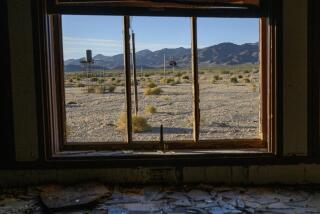A chilling forecast
- Share via
There’s always a new report about global warming, but the one released by the U.S. Department of Agriculture, with its charts on optimal temperatures for soybeans and peanuts, is downright creepy in its detail. This isn’t your usual futuristic fodder, with vague but dire predictions. The USDA report is more frightening because it states matter-of-factly the practical changes in farming, forestry and water that are transforming the landscape now and will do so again over the next few decades.
The Senate is scheduled to vote this week on a sweeping bill that would require carbon emissions to be slashed 70% by mid-century. Its chances for passage are slim; President Bush opposes it, as he has opposed all meaningful attempts to curb global warming, on the grounds that it would harm the economy. He ought to read the USDA study, along with a similar but more comprehensive report released last week by his science advisors, which specifies the effects of global warming and its very real costs.
The USDA analysis points out the quandary we’re already in after decades of inaction: The impacts during the next few decades are unavoidable. “Much of this change will be caused by greenhouse gas emissions that have already happened,” the report says. In other words, we have to plan for adjusting to climate change, as well as preventing it from spiraling into a crisis in this century and beyond.
Though the report stops short of making recommendations, it implies the need for major shifts in agriculture. And there was some good news, though not as much as the bad. Northern latitudes will experience milder winters -- good for cattle -- and longer growing seasons, but also longer lifetimes for harmful pests. The South might grow too hot for traditional crops such as peanuts and watermelon. The eastern United States will get more rain, but weeds, flourishing in the presence of increased carbon dioxide, will migrate north. Crops that require cold snaps are in trouble.
The prognosis for California is especially discouraging. With a smaller snowpack and less rain, the state will experience longer and more severe droughts. Some crops in the San Joaquin and Salinas valleys might find higher temperatures intolerable, threatening the state’s status as a food bowl for the nation. California, though stymied by federal regulators, has led the nation in trying to combat greenhouse gases. But it has been slower to take practical steps to adapt to the warming it can’t prevent. The state cannot put off water conservation measures, and with longer and more dangerous fire seasons, it cannot afford to permit increased sprawl into forests and brush areas.
At the national level, the report should awaken the agriculture sector to the disruption ahead. If the farm lobby, which is powerful enough to continually win wasteful subsidies even though they benefit only a tiny minority, were to team up with environmentalists, imagine what they could do to fight climate change.
More to Read
Sign up for Essential California
The most important California stories and recommendations in your inbox every morning.
You may occasionally receive promotional content from the Los Angeles Times.










